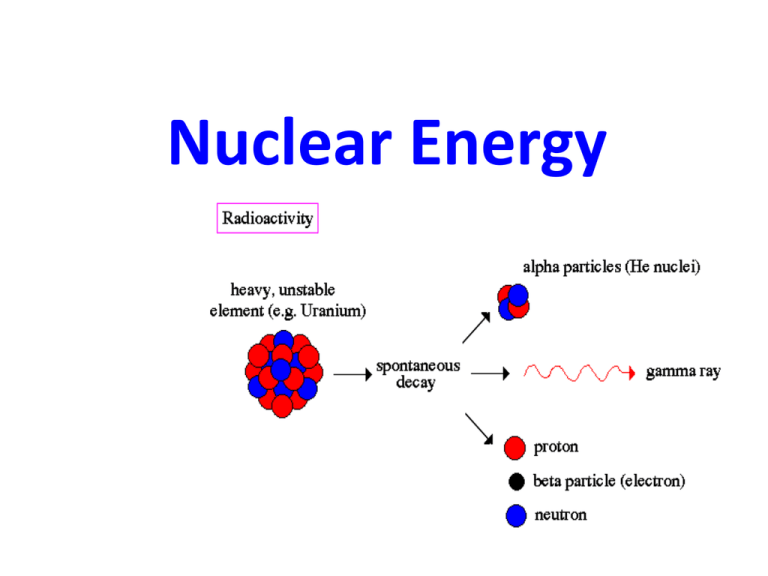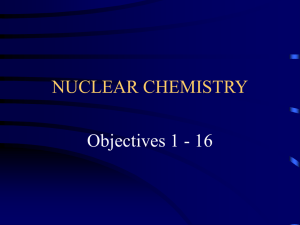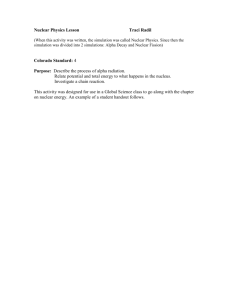III.) Section 10.4: Fission and Fusion
advertisement

Nuclear Energy A. What does “radioactive” mean? 1. Radioactive materials have unstable nuclei, which go through changes by emitting particles or releasing energy to become stable a. Call this nuclear decay B. Types of Radiation 1. Nuclear Radiation: the particles that are released from the nucleus during radioactive decay a. When a radioactive nucleus decays, the radiation leaves the nucleus b. IMPORTANT This may form an isotope of the same element or make a new element Types of radiation • • • • 1. 2. 3. 4. Alpha particle Beta particle Gamma ray Neutron 2. Alpha Particle: a positively charged particle that consists of 2 protons and 2 neutrons (2P + 2N) a. + charged b. Most massive- Do not travel far through materials (cannot pass through a piece of paper) c. Symbol: 42He d. Ex. Uranium-238 is radioactive and releases alpha particles Alpha Particle 3. Beta Particle: a negatively (-) charged electron emitted during radioactive decay a. Fast-moving electron- MADE FROM A NEUTRON THAT DECAYS & FORMS A PROTON AND A eb. THE PROTON STAYS AND THE e- LEAVES THE ATOM c. Can penetrate sheet of paper, but stopped by 3 mm of aluminum d. Symbol: 0-1e Beta Particle 4. Gamma Rays: high-energy radiation emitted during radioactive decay and nuclear fission -Marie Curie- isolated radium & saw it emitted gamma rays a. Gamma rays are a form of electromagnetic energy so they are “not charged” and “not made of matter” b. Not stopped by clothing or most building materials, (can penetrate up to 60 cm of Al or 7 cm of Pb) so are much more dangerous c. Symbol: γ Gamma Rays Neutron Emission • No charge; • Need 15 cm Pb to stop fast moving neutrons Nuclear Decay • When an unstable nucleus emits alpha or beta particles; # of P & # N changes • Alpha Decay- lose 2 P + 2 N (same as He atom)- causes the mass number to decrease by 4 & the atomic number to decrease by 2 • Example: The process of alpha decay of radium-226 is written as follows. 226 222 Rn + Ra → 88 86 4 2He Nuclear Decay • Beta Decay- gain 1 P + lose 1 N (remember a neutron decays to form 1 P & 1 e- (the proton stays and the e- leaves) • Example: Carbon-14 decays to nitrogen-14 by emitting a beta particle • 14 14 N + 0 e C → 6 7 -1 • Gamma Ray decay- no change in # P; energy content changes in the matter it hits C. Decay Rates 1. Half-life: time required for half of a sample of radioactive substance to decay -1st half life = ½ sample remains -2nd half life = ½ x ½ = ¼ sample remains -3rd half life= ½ x ½ x ½ = 1/8 sample remains 2. Use these decay rates to tell the age of rocks and fossils (radiometric dating) a. Carbon-14 is common isotope used in radiometric dating Nuclear Reactions • Strong Nuclear Force- force that causes protons & neutrons to attract each other in the nucleus • Protons are + and repel each other • Neutrons have no charge so they help create the strong nuclear force to hold protons & neutrons together in the nucleus Nuclear Reactions • Stable Nuclei- strong nuclear force is stronger than the repulsion force • Unstable Nuclei- strong nuclear force is less than the repulsion force A. Have too many or too few neutrons in nucleus B. Have more than 83 protons in nucleus C. Will decay (and release radiation) into a more stable nucleus II.) Nuclear Reactions A) Nuclear Fission: the process by which a nucleus splits into two or more smaller atoms and releases neutrons and energy 1. In nuclear fission, tremendous amounts of energy can be produced from very small amounts of mass (Fig. 7 p.295) Nuclear Fission • 235 U 92 + 10n → 13756 Ba + 8436 Xe + 15 10n + energy 2. Converting Mass into Energy a. Albert Einstein introduced the mass-energy equation: 2 E = mc b. According to the law of conservation of mass and energy, the total amount of mass and energy remains constant c. Mass defect- the total mass of any nucleus measured is less than the sum of the individual masses of protons & neutrons that form it; SOME OF THE MASS HAS TURNED INTO ENERGY!! Converting Mass into Energy • The amount of energy released during nuclear fission is related to the mass that is turned into energy • E = mc2 3. Triggering a Nuclear Chain Reaction a. Nuclear fission follows a pattern of a chain reaction; The speed of a chain reaction can vary b. Chain reaction: a continuous series of nuclear fission reactions [Fig 8 p.296] c. Nuclear fission releases more neutrons which trigger more fission reactions d. The number of neutrons released determines the success of a chain reaction Nuclear Chain Reaction c. Nuclear weapons- ex. Atomic bombs (use U-235 or Pu-239) are designed to have an uncontrolled chain reactions d. Nuclear Power Plants- A controlled chain reaction, heat from the reaction can be used to generate electrical energy -controls chain reaction with control rods that absorb neutrons emitted after fission reaction c. Critical Mass: the minimum amount of a substance that can undergo a fission reaction and can also sustain a chain reaction. 4. Nuclear Energy From Fission a. Nuclear power plants generate about 20% of electricity in the U.S. b. Controlled fission of uranium-235 in a fission reactor c. Don’t emit air pollutants, but have other safety concerns d. 1986: meltdown of reactor at Chernobyl nuclear power plant in Ukraine B. Fusion: the process in which smaller nuclei fuse together at extremely high temperatures and release energy (occurs in stars like the sun) C. Light nuclei combine to form heavy nuclei 1. In nuclear fusion, tremendous amounts of energy can be produced from very small amounts of mass 2. THE FUSION OF HYDROGEN RELEASES MORE ENERGY THAN THE BURNING OF NATURAL GAS, BURNING OF COAL, OR THE FISSION OF URANIUM-235!! Fusion • Nuclear fusion plants using hydrogen may be a possibility one day • 1 pound of hydrogen in a fusion reactor may release as much energy as 16 million pounds of burning coal!! Fusion Reaction . 2H + 3 H 4He + 1n 1 1 2 0 3. Requires extremely high temperatures—i.e. Sun reaches temp of 10,000,000oC -need a lot of energy to overcome repulsion force of protons 3. Fusion may someday provide clean and efficient source of electricity 5. Two problems creating a fusion reactor: a. Need very high temperatures to start reaction b. Must contain plasma Nuclear Radiation Today • Background Radiation- all around us; comes from natural sources like the sun, plants, water, heat, soil, rocks, etc. ( due to the fact that radioactive isotopes live there) • Exposure varies from one location to another • ex. Living in higher altitudes or around rocks increases radiation exposure • -Also, things like smoking, getting x-rays Beneficial Uses of Radiation • 1. Smoke detectors- release alpha particles which are charged & release an electric current, smoke decreases the flow of current which sets off the alarm • 2. Used to detect disease• A). X-rays • B). MRI • C). Radioactive tracers- isotopes that concentrate in affected areas to locate tumors Nuclear Radiation is used to treat cancer • Radiotherapy- is a treatment that uses controlled doses of nuclear radiation for treating diseases such as cancer • Ex. A) Brain tumor- uses gamma rays to treat them • B) iodine isotopes treat thyroid cancer • C) Radiation is used to kill defective bone marrow of leukemia patients • Agriculture- radioactive tracers move through crops to see how fast water moves through them.







